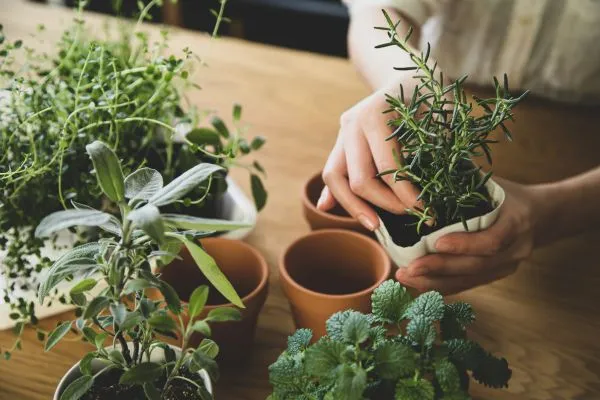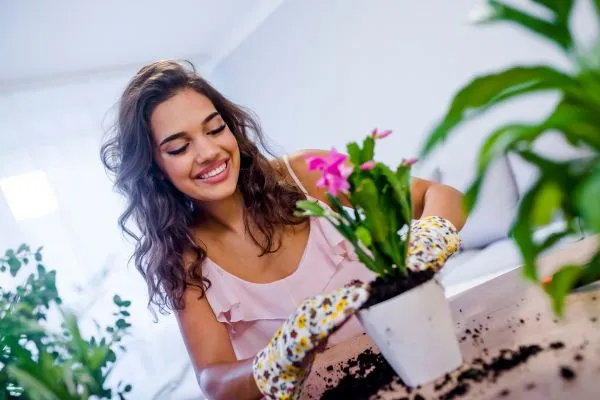Are you tired of relying on the grocery store for fresh produce? Do you dream of having your own mini garden right in the comfort of your home?
If so, it’s time to master the art of growing indoor food plants. In this comprehensive guide, we will take you through everything you need to know to successfully cultivate and harvest a wide variety of edible plants indoors.
From selecting the right plants to providing them with optimal growing conditions, we’ve got you covered. So let’s roll up our sleeves and embark on this exciting journey of indoor gardening!
What you should know before starting

Indoor gardening has gained immense popularity in recent years, and for good reason. It allows you to grow your own food year-round, regardless of the weather outside.
Not only does it provide you with a fresh and nutritious food source, but it also adds a touch of greenery and natural beauty to your living space.
Whether you have a spacious apartment or a tiny studio, there’s always room for a few pots of herbs, vegetables, or fruits.
In this article, we will delve into the art of growing indoor food plants, sharing expert tips and tricks to help you become a successful indoor gardener.
We will cover various aspects of indoor gardening, including selecting the right plants, creating an ideal growing environment, understanding the importance of light and water, tackling common challenges, and reaping the bountiful harvest of your hard work.
So, if you’re ready to take the plunge into the world of indoor gardening and embark on a rewarding and sustainable journey, let’s get started!
Selecting the Right Plants for Indoor Gardening
Choosing the right plants is the first step towards mastering the art of growing indoor food plants.
Not all plants thrive indoors, so it’s important to select varieties that are well-suited to the indoor environment. Here are some popular choices that are known for their adaptability and productivity indoors:
1. Herbs
Herbs are a fantastic choice for indoor gardening, as they are compact, low-maintenance, and add a burst of flavor to your culinary creations. Popular herbs for indoor gardening include:
- Basil
- Mint
- Parsley
- Rosemary
- Thyme
2. Leafy Greens
Leafy greens are packed with nutrients and can be harvested multiple times, making them ideal for indoor gardening. Consider growing the following leafy greens indoors:
- Spinach
- Lettuce
- Kale
- Swiss Chard
- Arugula
3. Microgreens
Microgreens are the tiny, edible seedlings of vegetables and herbs. They are nutrient-dense and can be grown in small containers, making them perfect for indoor gardening. Some popular microgreens to grow indoors include:
- Radish
- Pea shoots
- Sunflower sprouts
- Broccoli sprouts
- Mustard greens
4. Dwarf Fruit Trees
If you have ample space and a green thumb, you can even try growing dwarf fruit trees indoors. While they require more care and attention, the reward of plucking your own homegrown fruits is unparalleled. Consider growing these dwarf fruit trees indoors:
- Citrus trees (lemon, lime, or kumquat)
- Fig tree
- Olive tree
- Avocado tree
By selecting the right plants based on your preferences and available space, you can set the foundation for a successful indoor garden.
Creating an Ideal Growing Environment
To ensure your indoor food plants thrive, it’s essential to create an ideal growing environment that mimics their natural habitat. Here are some factors to consider:
1. Light
Light is one of the most critical factors for plant growth. While most indoor plants require bright light, the intensity and duration may vary. Some plants thrive in direct sunlight, while others prefer indirect or filtered light. Place your plants near windows or use grow lights to provide them with the required amount of light.
2. Temperature and Humidity
Different plants have different temperature and humidity requirements. Most indoor plants prefer temperatures between 65-75°F (18-24°C) during the day and slightly cooler temperatures at night.
Additionally, maintaining adequate humidity levels can be challenging, especially during the winter months when indoor heating can cause the air to become dry.
To increase humidity, you can use a humidifier, place a tray of water near the plants, or mist the leaves regularly.
3. Air Circulation
Good air circulation is crucial for preventing the buildup of pests and diseases. Make sure there is proper ventilation in the room where you’re growing your plants.
You can use fans or open windows to ensure fresh air circulates around your indoor garden.
4. Soil and Containers
Choosing the right soil and containers is essential for the health and growth of your indoor food plants. Use a well-draining potting mix that is specifically formulated for indoor plants.
Select containers with drainage holes to prevent waterlogging, which can lead to root rot. Additionally, consider the size of the container based on the plant’s growth habits and root system.
By providing your indoor food plants with the ideal growing conditions, you set them up for success and maximize their productivity.
Master the Art of Watering Your Indoor Food Plants
Watering is a fundamental aspect of plant care, and it’s crucial to get it right to ensure your indoor food plants thrive. Here are some essential watering tips to keep in mind:
1. Know Your Plants’ Watering Needs
Different plants have different watering requirements. While some prefer consistently moist soil, others need periods of drying out between waterings. Research the specific needs of each plant you’re growing and tailor your watering routine accordingly.
2. Check Soil Moisture Regularly
Get into the habit of checking the moisture level of your plants’ soil regularly. Stick your finger about an inch into the soil to assess its moisture content. If it feels dry at that depth, it’s time to water. If it’s still moist, hold off on watering for a little longer.
3. Water Thoroughly
When you water your indoor food plants, ensure that you do so thoroughly. Water until it drains out of the bottom of the pot, ensuring that the entire root system receives moisture. This helps prevent the accumulation of salts and mineral deposits in the soil.
4. Use Room Temperature Water
Avoid using cold water straight from the tap, as it can shock the plants’ roots. Instead, fill a watering can and let it sit for a few hours to reach room temperature before using it to water your plants.
5. Consider the Season
During the growing season, plants generally require more water, while they may need less water during the dormant period.
Adjust your watering frequency accordingly to accommodate the seasonal needs of your indoor food plants. Proper watering practices are vital for maintaining the health and vitality of your indoor food plants.
By understanding your plants’ water requirements and providing them with the right amount of moisture, you can foster robust growth and bountiful harvests.
FAQ
Q: How much light do indoor food plants need?
Indoor food plants generally require bright light to thrive. Most plants need at least 6-8 hours of direct or indirect sunlight per day.
However, the specific light requirements may vary depending on the type of plant. Some plants, such as herbs and leafy greens, can tolerate lower light conditions, while others, like fruiting plants, need more intense light.
Consider the natural light availability in your space and supplement it with grow lights if necessary.
Q: Can I use regular garden soil for indoor gardening?
No, it’s not recommended to use regular garden soil for indoor gardening. Garden soil is heavy and may contain pests, diseases, and weed seeds.
Instead, opt for a high-quality potting mix that is specifically formulated for indoor plants. Potting mixes are lighter, well-draining, and sterile, providing the ideal growing medium for your indoor food plants.
Q: How often should I fertilize my indoor food plants?
Indoor food plants benefit from regular fertilization to ensure they receive the necessary nutrients for healthy growth.
However, the frequency of fertilization depends on the type of plant and the specific fertilizer you’re using.
Generally, it’s advisable to fertilize once a month during the growing season (spring and summer) and reduce or stop fertilization during the dormant period (fall and winter).
Follow the instructions on the fertilizer packaging for the recommended dosage and frequency.
Q: How do I prevent pests from infesting my indoor food plants?
Pests can be a common challenge in indoor gardening. To prevent pest infestations, maintain good plant hygiene by regularly removing dead leaves and debris.
Inspect your plants regularly for signs of pests, such as sticky residue, chewed leaves, or visible insects.
If you spot any pests, isolate the affected plant and treat it with an appropriate organic pesticide or insecticidal soap. Additionally, promoting good air circulation and avoiding overwatering can help prevent pest problems.
Q: Can I grow indoor food plants without natural sunlight?
While natural sunlight is ideal for indoor gardening, it’s possible to grow certain food plants without it.
You can use artificial grow lights, such as fluorescent or LED lights, to provide the necessary light spectrum for plant growth.
Position the lights a few inches above the plants and ensure they are on for 12-16 hours a day. However, keep in mind that some plants may still require a certain amount of natural sunlight to thrive.
Q: How long does it take for indoor food plants to mature and produce harvestable crops?
The time it takes for indoor food plants to mature and produce harvestable crops varies depending on the type of plant and growing conditions.
Leafy greens and herbs can typically be harvested within a few weeks to a couple of months, depending on the variety.
Fruiting plants, such as tomatoes or peppers, may take longer, usually ranging from two to six months. Read the seed packets or plant labels for specific information on the average time to maturity for each plant.
By understanding the needs of your indoor food plants and providing them with the right care and attention, you can overcome challenges and enjoy a fruitful indoor gardening experience.
Conclusion
Mastering the art of growing indoor food plants is an incredibly rewarding journey that allows you to nurture and harvest your own fresh produce right at home.
By selecting the right plants, creating an ideal growing environment, understanding watering techniques, and addressing common challenges, you can cultivate a thriving indoor garden.
Remember to research the specific needs of each plant you’re growing and tailor your care accordingly.
With patience, dedication, and a green thumb, you’ll be well on your way to becoming a successful indoor gardener. So roll up your sleeves, get your hands dirty, and enjoy the fruits of your labor!
